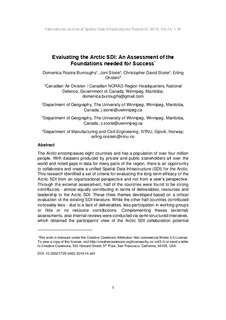| dc.contributor.author | Burroughs, Domenica | |
| dc.contributor.author | Storie, Joni | |
| dc.contributor.author | Storie, Christopher | |
| dc.contributor.author | Onstein, Erling | |
| dc.date.accessioned | 2019-09-05T13:48:43Z | |
| dc.date.available | 2019-09-05T13:48:43Z | |
| dc.date.created | 2018-11-27T15:35:44Z | |
| dc.date.issued | 2019 | |
| dc.identifier.citation | International Journal of Spatial Data Infrastructures Research. 2019, 14 1-34. | nb_NO |
| dc.identifier.issn | 1725-0463 | |
| dc.identifier.uri | http://hdl.handle.net/11250/2612710 | |
| dc.description.abstract | The Arctic encompasses eight countries and has a population of over four million people. With datasets produced by private and public stakeholders all over the world and noted gaps in data for many parts of the region, there is an opportunity to collaborate and create a unified Spatial Data Infrastructure (SDI) for the Arctic. This research identified a set of criteria for evaluating the long-term efficacy of the Arctic SDI from an organizational perspective and not from a user’s perspective. Through the external assessment, half of the countries were found to be strong contributors - almost equally contributing in terms of deliverables, resources and leadership to the Arctic SDI. These three themes developed based on a critical evaluation of the existing SDI literature. While the other half countries contributed noticeably less - due to a lack of deliverables, less participation in working groups or little or no resource contributions. Complementing theses (external) assessments, also internal reviews were conducted via semi-structured interviews, which obtained the participants’ view of the Arctic SDI collaboration potential successes and shortcomings. The interviewees identified opportunities, limitations and risks as they perceived them. Most of the issues associated with the opportunities, limitations and risks could be cross-validated with the external assessment criteria. However, the importance of communication was strongly emphasized in the interviews and was not represented by the external assessment criteria. The completion of both the external and internal assessments led to the multi-view framework that can be used to assess the long-term potential of the Arctic SDI. This evaluation tool can also be used for defining tasks and clarifying responsibilities for the next 5-year Memorandum of Understanding (2019-2024) or to assess the Arctic SDI to identify challenges and mitigation measures that would assist in its longevity. This tool can also be used for other regional SDIs to define MoUs and assess the potential for success. | nb_NO |
| dc.language.iso | eng | nb_NO |
| dc.publisher | Publication Office of the European Union | nb_NO |
| dc.relation.uri | http://ijsdir.jrc.ec.europa.eu/index.php/ijsdir/article/view/490 | |
| dc.rights | Navngivelse-Ikkekommersiell 4.0 Internasjonal | * |
| dc.rights.uri | http://creativecommons.org/licenses/by-nc/4.0/deed.no | * |
| dc.title | Evaluating the Arctic SDI: An Assessment of the Foundations needed for Success | nb_NO |
| dc.type | Journal article | nb_NO |
| dc.type | Peer reviewed | nb_NO |
| dc.description.version | publishedVersion | nb_NO |
| dc.source.pagenumber | 1-34 | nb_NO |
| dc.source.volume | 14 | nb_NO |
| dc.source.journal | International Journal of Spatial Data Infrastructures Research | nb_NO |
| dc.identifier.doi | 10.2902/1725-0463.2019.14.art1 | |
| dc.identifier.cristin | 1635918 | |
| dc.relation.project | SiU, Senter for internasjonalisering av utdanning: HNP-2015/10024 | nb_NO |
| dc.description.localcode | This work is licensed under the Creative Commons Attribution-Non commercial Works 3.0 License | nb_NO |
| cristin.unitcode | 194,64,94,0 | |
| cristin.unitname | Institutt for vareproduksjon og byggteknikk | |
| cristin.ispublished | true | |
| cristin.fulltext | original | |
| cristin.qualitycode | 1 | |

